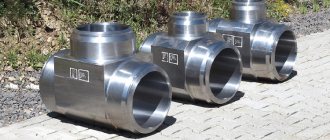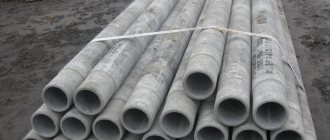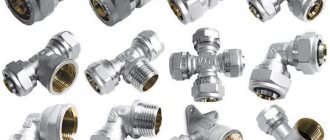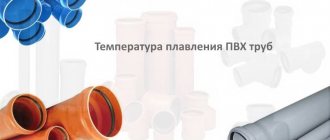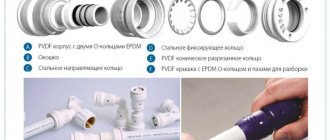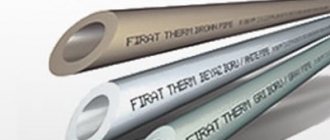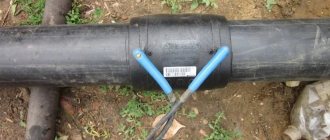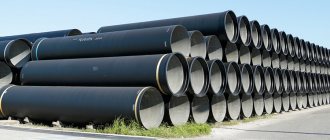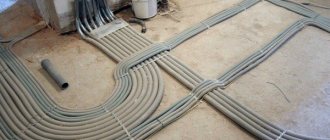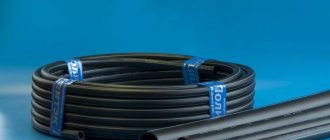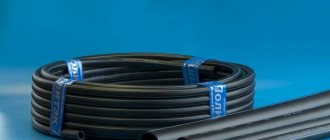Today, there are many options for connecting pipes in pipeline structures. The choice of connection depends on various factors, but the material from which the communication elements are made plays a major role. The second important factor is the type of work environment. It is also worth noting that the operating conditions of the pipeline play a big role.
The connection method is selected depending on the type of pipes, their diameter and the purpose of the future pipeline
Types of connections
All existing pipe connections are divided into two main groups:
- detachable;
- one-piece.
The use of detachable connections allows, if necessary, to disassemble the joint section. Thanks to this property, it is possible to repair and replace the joint without compromising the integrity of the pipes. Detachable joints include threaded connectors (fittings) and flanges.
In the case of permanent joints, it is possible to disassemble the pipeline, however, this will lead to damage to the pipe material. The most popular option for permanently connecting pipelines is welding. In addition, there are a number of other methods: gluing, pressing, installing a socket using cement mortar.
All of the above methods are quite popular and are used to connect pipelines transporting various media: water pipelines, heating communications, gas networks, sewer systems, as well as industrial and technical lines.
Need for repairs
In some cases, it is necessary, as an emergency, to replace the damaged area with a plastic pipe, and to do this as quickly as possible.
Yes, and when installing a new plumbing system, you often have to connect to an existing utility network consisting of steel or cast iron pipes (read about installing an acrylic bathtub in this article).
Be it connecting to the central water main of a private house or inserting a plastic pipe into the sewer riser of a high-rise building.
The use of threaded connections in such cases is not always justified, and sometimes it is impossible, for example, when connecting a heating expansion tank (how to calculate the capacity is written here) with a cast iron pipe.
Welded joints
Welding is a very popular method of joining individual parts in a pipeline structure. This method is especially in demand when installing technical communications in factories.
The most commonly used method for installing steel pipelines is hot welding.
It is worth noting that not only individual parts in metal structures, but also plastic products can be connected by welding. In some cases, welding is also used to join glass parts.
Depending on the method of exposure to the material, there are two main methods of such connection:
- fusion welding;
- pressure welding.
Fusion welding has many implementation options:
- electric arc;
- simple electric;
- electrobeam;
- laser;
- gas welding.
The most popular among these options is the first one. The use of electric arc welding implies that the heating source is an electric arc. This type of work can be performed in two ways:
- with alternating current;
- with direct current.
Helpful information! Butt welding of the connected pipeline elements allows the work to be carried out at lower financial costs. This is due to the fact that welding equipment is less expensive and also requires less energy consumption during installation.
Metal welding can be done with electric or gas equipment
This type of installation can be carried out using various equipment, so three types of welding can be distinguished:
- manual;
- semi-automatic;
- automatic.
Types of welded joints
There are different methods for welding individual parts in pipeline communications. Let's look at them:
- end-to-end;
- overlap;
- corner;
- with welding of various elements.
The most popular and common are the following welding connections:
- Butt (longitudinal and transverse). With this welding option, backing elements - rings - can be used. The seam in such joints can be one- or two-sided. The latter is used in cases where the part has a large cross-section - more than 500 mm.
- Angular (one-sided and two-sided). This option can be done in different ways. In some cases, corner joints are welded with an edge bevel, and in others - without it.
- Socket-welded overlap clutch. The socket connection is used to join pipeline elements with a high ductility coefficient. These include parts made of non-ferrous metals, as well as plastic elements.
In addition, square pipes, which are used in construction and the production of various furniture, are also connected by welding. They are not suitable for installation of pipelines. This is due to the shape of their cross-section - it worsens the flow characteristics, while round is the best option for pipeline structures.
Butt welding is used for pipes whose diameter exceeds 50 mm
Threaded connections
But what to do in cases where it is not possible to carry out welding work? There are quite a few ways to join pipeline elements without welding. The most popular option is threaded installation. Pipe threading is done using cutting machines or an ordinary die. If it is necessary to apply threads to a product with thin walls, use the rolling method.
If you follow all the rules for installing a threaded joint, you will get a durable and sealed structure. Let's consider the main advantages of using such a connection:
- ease of installation.
- the ability to repair or replace without damaging the pipeline;
- installation is carried out without the use of special equipment.
In addition, there are several thread parameters that determine its operation:
- cutting step;
- depth;
- direction.
The pitch determines the distance between the top of the coil and its base. Depth is a parameter that is determined as follows: the distance between the base of the coil and its top is measured. The direction of the thread is an important point; if you ignore it, you may encounter problems when installing the pipeline structure. The thread has two directions:
- right;
- left.
Many types of pipes are equipped with threads; they are used where it is necessary to create a reliable but detachable connection
Plumbing or heating
Metal pipes in the plumbing and heating systems (how to install them in a private house is written here) have one unpleasant feature - threaded and welded connection points, after several years (15-20), become completely unusable.
At the same time, the condition of the pipe itself is still quite satisfactory, but the pipes are so corroded that during the next heating season they can easily break, with all the ensuing consequences.
There is only one way out here - to completely replace the unreliable section.
To replace, you can use a piece of pipe made of metal or polypropylene. The main feature is that we will use a threadless connection. For this purpose, threadless compression fittings are used.
What do you know about electric welded couplings? They are used for joining pipes in hard-to-reach places when laying and repairing water mains. Read how to use them in this useful article.
About making countertops from artificial stone for the bathroom is written on this page.
In everyday life, they are all often called GEBO (gebo), but this is also not correct, just like calling all SUVs jeeps, and all copiers copiers.
Simply, GEBO was the first to produce such compression fittings, and over time, the name stuck.
Today, such devices are produced by many companies, and on the market you can find both more expensive and high-quality ones, and cheaper ones.
This technology can easily be used when laying a system from scratch , but it has found particularly wide application specifically when carrying out repair work.
Such fittings can be used anywhere where the temperature does not exceed plus 90 degrees, which means they are suitable for both hot water (read about a heated outdoor Jacuzzi pool here) and for a heating system.
There is no need for thread cutting or welding, which greatly reduces time and costs.
Other types of pipe joining without welding
The use of threaded connections is the most popular and widespread method of installing pipeline structures without welding. However, there are other types of pipe connections that are worth paying attention to.
The choice of method, as a rule, depends on the material from which the pipeline is made. All pipes can be divided into two types:
- flexible;
- hard.
The first group includes products that consist of various polymer materials: polypropylene (PP), polyethylene (PE), as well as metal-plastic products. The second group does not have such ductility and includes: steel, cast iron, polyvinyl chloride (PVC), copper, etc.
Important! When installing flexible pipelines, greater coverage of the pipe material is required to ensure a reliable connection than when implementing joints in rigid pipelines.
General thread requirements
The connections are used at the joints of steel heating pipes, water pipes, and gas risers, where welding can be avoided. On ordinary risers, the thread is cut, but on thin-walled products it is applied by rolling.
Main requirements:
- Correctly, well-cut threads must be clean;
- the thread is considered defective if it is torn or incomplete;
- the length of the thread should not be more than one tenth of the length of the part;
- on couplings, it should be of such a size that when the ends of the pipes are fully screwed in, a gap of up to 0.5 cm remains between them (this is the so-called short threaded connection);
- When twisting “one cylinder onto another cylinder”, they use bends. A bend is a piece of pipe with threads on both ends with a coupling and lock nut screwed onto them.
Important! A high-quality squeegee should have a long thread at one end (22-27 threads), and a short thread at the other (5-7 threads)
Connecting flexible pipes without welding
Often, in order to install a pipeline without the use of welding equipment, special connecting elements - fittings - are used. Fittings for flexible pipes must have a large reach to make a reliable and airtight joint.
Compression fittings allow you to create a tight connection without welding or threading
As a rule, fittings are used in flexible pipelines that have small or medium cross-sections (from 20 to 315 mm). For parts with a diameter above 315 mm, a fitting joint is not practical. This is due to the fact that the reliability of such a connection is quite low.
For joining low-pressure polyethylene (HDPE) products, special compression fittings are mainly used. The joining of individual elements in a pipeline structure using compression products allows for quick installation, which is also inexpensive and simple.
However, compression products are most often used to connect small diameter pipes. Medium-diameter pipes are connected using couplings. The coupling is perhaps the most common fitting option.
Connecting rigid pipes without welding
As mentioned above, inelastic pipes are often joined using threads. But there are methods that allow you to connect individual elements of rigid pipelines without the use of welding and threading. Docking without welding equipment is permitted on parts with a diameter of up to 600 mm.
If it is not possible to cut a thread on a rigid pipe or use welding for joining, then the pipeline is mounted using couplings
In order to install a rigid structure without the use of welding equipment, couplings are usually used. The coupling joint allows you to connect the following pipe options:
- equal in diameter;
- with different diameters;
- from various materials.
The connection obtained using such a fitting is characterized by high strength characteristics and good tightness. If it is necessary to connect two pipes without welding and threading, as a rule, special devices are used - flanges. They are also widely used for connecting various equipment to pipes.
Flange connections are recommended for use in cases where a specific section of the pipeline requires frequent inspections or periodic repairs. This is due to the fact that such a clutch is easy to disassemble and reassemble. It includes:
- two connecting flange elements;
- sealing ring;
- nuts and bolts.
Repair and installation clip
A universal product that can be used to repair pipe metal products without welding, as well as polyethylene pipes, is a repair and installation clip.
It consists of two cast cages in the form of semi-bushings, having four ears for bolt fastening. The kit includes a rubber seal in the form of a hose cut to length and four bolts.
In essence, it is a clamp that plumbers often use, but it is made very well. Available for pipes of different diameters, making it possible to repair them without welding or threading.
The product is used for repairing damaged pipelines for various purposes. If a through hole appears in the pipe, a split seal is placed on the damaged area, oriented with the cut in the direction opposite to the damage.
Clips are installed on top of the seal and the bolts are tightened. These repairs do not require welding and can sometimes be done under pressure without shutting down the pipeline.
Non-standard methods of connecting pipes
In addition to the traditional methods of joining pipes, which are the most common, there are also some special installation methods. Pipes can also be made of non-standard material, which requires a special connection.
Sockets are most often used to connect sewer systems
Let's consider the following docking methods:
- gluing;
- bell joint;
- quick connectors.
The first option is used if the structure is made of plastic. The gluing method allows you to obtain a strong and hermetically sealed permanent connection. Joining pipes in this way is done by applying a special glue to them.
The socket connection is used, as a rule, when installing non-pressure sewer systems. In such systems, wastewater moves naturally at an angle, without the use of a special pump. Depending on what material such a pipeline is made of, there may be a detachable or permanent socket connection. The detachable version of the socket coupling is used when installing plastic communications, and the one-piece version is used when installing cast iron pipes. The socket is sealed in cast iron structures using a cement composition or special sealants.
Helpful information! Quick-release or quick-release connections are installed if the operational features of the communication require its frequent disassembly.
Let's look at the main options for quick-release connections:
- clamps equipped with a fixing wedge;
- cam (Camlok);
- ISO connection.
Flexible pipes and hoses can be connected using quick connect fittings such as Camlok
These clutch options are easy to install and have good strength characteristics.
It is also worth noting that for joining pipes that are used for industrial purposes, the following joints are used:
- nipple;
- telescopic;
- articulated.
The first option is used in cases where it is necessary to connect pipes with any measuring equipment, and the second - when joining rigid pipes equipped with flexible elements. The hinged type is used in the construction of highways with complex shapes. This connection allows you to compensate for the effect of twisting the pipeline.
Material orientation
When starting serious work - choosing an option for joining sewer pipes, it is important to find out in advance what material you will have to deal with.
Today the following products are used in drainage systems:
The first two types of material are most often used, while the others are quite rare. Corrugated pipes are in demand in external pipelines of private buildings or as components of networks of large production facilities.
Cast iron pipes are used in external drainage systems. Compared to steel ones, they are quite heavy, so they are not suitable for internal sewerage, especially if they are installed by one person. But at the same time, cast iron pipes are not afraid of corrosion, like steel ones, and have a long service life, and are also in demand in heating systems, in particular, when installing risers. Although not every person will connect complex elements in cast iron pipes. The disadvantage of such products is the regular adhesion of waste inside the pipe due to the uneven surface. In winter, during the heating season, they are more susceptible to clogging. Compared to them, polymer products are more practical.
Features of connecting profile pipes
Profile pipes have good strength and relatively low weight, so they are often used for the installation of frame structures, as well as for other construction purposes.
The shape of profile pipes can be:
- rectangular (the most common shape);
- square;
- ovoid (oval);
- others (more complex forms).
The most reliable way to create structures from profile pipes is to fasten them by welding
Electric arc welding is usually used to connect square pipes. There are also special connections that are made using bolts and rivets. Square and rectangular pipes are joined using the same methods.
In addition, various parts can be joined to such pipes. This joining is carried out using self-tapping screws. These elements do not require preliminary holes.
Double-sided crimp connections
A universal product with which you can connect steel pipes, as well as PVC pipes. It is this fitting that is most often called the Gebo coupling. It can be used to connect two pipes end to end.
To make a connection, the pipes must be cut evenly and cleaned of dirt and rust, the ends of the pipes must be well processed. A clamping nut is put on the end of the pipe, then a clamping washer, which is a collet - a conical bushing with a cut on one side.
The inner side of the bushing is covered with circular notches. A sealing gasket is inserted into the coupling seat, designed to stop the end of the pipe. After this, the clamping nut is tightened.
Moving along the thread, the hole in the nut presses the conical part of the split sleeve against the pipe. At the same time, the internal notches of the sleeve cut into the surface of the pipe, tightly fixing it and pressing it against the end gasket. This way ensures the necessary tightness and mechanical strength of the connection.
A similar procedure is performed on the second side of the coupling, where the end of the second pipe is inserted.
Connecting profile pipes without welding
Joining of profile pipes can be carried out without the use of welding equipment. How to connect profile pipes without welding:
- use of a crab system;
- fitting connection.
The crab system for pipes consists of connecting brackets and fixing elements. The connection in this case is made using nuts and bolts and ultimately forms an “X”, “G” or “T”-shaped profile structure. With this connection you can connect from 1 to 4 pipes, but only at right angles. They are as strong as welded seams.
A fitting connection is used when it is necessary to make a branch from the main pipe. There are several types of pipe connectors that allow you to mount workpieces in different configurations. The main ones:
- coupling;
- corner;
- tee;
- cross.
Crab systems are most often used when installing simple outdoor structures, such as a greenhouse or shed
How to connect pipes from different materials?
In some cases, it is necessary to connect products that are not homogeneous in material. There are special options for these purposes.
How to connect a polypropylene (plastic) pipe to a metal one?
Many people ask the question: how to connect polypropylene pipes with metal ones? There are several popular methods for this:
- thread;
- flange pipe connection.
In the first case, the coupling of pipes of heterogeneous material is carried out using couplings. One end of such a coupling is equipped with a thread, and the other has a smooth surface for joining with polypropylene.
The flange method involves the use of flanges. This connection is made using studs and bolts.
Note! Flanges are used in structures that are often disassembled during operation.
How to connect metal-plastic pipes with metal ones?
The most popular options in this case are:
- press fittings;
- compression fittings.
In the first case, the connection between pipes of heterogeneous material can be made in two ways:
- sliding press fitting;
- crimp coupling.
It is important to remember that connecting metal-plastic pipes with metal and other pipes of heterogeneous material is quite a responsible undertaking and should be carried out by specially trained specialists. Incorrect installation of the connecting element will lead to an emergency in the pipeline.
The main subtleties of laying external sewerage
Fittings are used when arranging intra-house or intra-apartment sewerage. The situation is completely different with the external system, which is installed on the site near the house. In this case, it is necessary to start with the construction of wells intended for water purification.
Having understood how to join drainage pipes, it becomes clear that the external system requires products of larger diameter.
It is imperative to take into account the fact that the diameter of the outer pipe should be slightly larger than the size of the sewer pipe. It is better to take material with a “reserve” than to change the entire drainage system when there is a desire to connect new plumbing fixtures.
Having completed the preparatory steps, you can begin the serious business of connecting sewer pipes. According to the types and joints of pipes, two connection options are distinguished: detachable and permanent.
